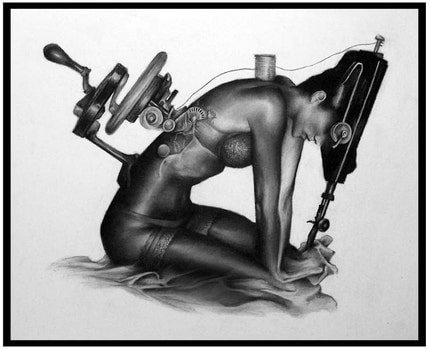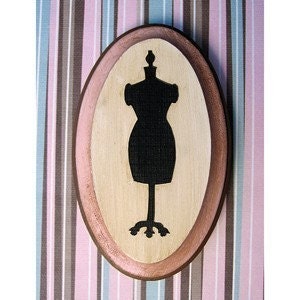Starting from Scratch
So you want to be a fashion designer, but you don’t even know how to sew… That’s fine. No one comes out of the womb knowing how to use and draft patterns or operate a sewing machine, so let’s not get ahead of ourselves.
Setting Goals
Your first step is to set goals. Yes, you want to be a fashion designer, but does that mean you want to go the DiY route and sell from home? Or do you want to be on Project Runway? Or maybe you’d like to work under a big, famous designer or better yet, BE one.
When you’re setting your goals, think about what it is that you want. Sure, there’s a chance you’ll eventually make it big by running a small DiY fashion biz out of your kitchen, but if you want your own store on Madison Avenue, you might want to think about taking some classes, or even getting a degree in a fashion related field. I’m not saying that starting out with a DiY set-up can’t get your name in lights, but this guide is meant for people that simply want to make a living or supplement their current income by selling their craft. I have no experience with making it big, so this is geared towards those of us that are okay with being the little guy. Either way, you’re going to need a hell of a lot of patience and practice.
Start Small
Once you’ve figured out your long term goals, think of the things you’ll need to get you there. Baby steps. If you don’t know how to sew, then that should be number one on your list of goals. Don’t get ahead of yourself with dreams of your awesome one-of-a-kind creations and internet fame when you haven’t even got the skill down yet! Just imagine if you planned all of this out, only to discover that you hate sewing. Bummer, dude.
A huge bonus to selling your craft for a living is that you are your own boss, and you get to set your own pace and your own rules. Don’t blow it by picking something you hate doing. If you’re going to hate your job, then you might as well go sit in an office and get the benefits of a mainstream job! Which leads me to:

Reality Check
Be realistic when you’re thinking about starting your own craft business. If you think you’re going to make a load of cash selling your stuff, or you think you’re going to be an instant success, you’re probably going to be incredibly disappointed, or worse: broke. It takes a long time to get your name out there and develop a loyal customer base. It was 2 years before I got to the point where I was making a small profit off of selling my designs.
You will be lucky just to BREAK EVEN your first two years. Most people report a loss or quit before they even get that far.
So… yes, there are huge bonuses to being your own boss, but there are also some definite drawbacks. Let’s do an old-fashioned Pro vs. Con showdown:
Pro
- You set your own schedule. Got kiddies to look after? Working for yourself can be a big bonus because you pick your hours. Just beware: many crafters with successful businesses work WAY MORE than full time (40 hours). The more successful people I know probably work an average of 10+ hours a day, 7 days a week. When you’re working that much, you better love what you’re doing.
- You can work in your pajamas, or a clown suit, or perhaps wear nothing at all (not recommended). The bottom line is, no dress code!
- You won’t come home at the end of the day burned out and hating your life. Well, at least I hope not.
- You can actually get paid for your effort! Most jobs pay you an hourly rate no matter what you do… Normal job= Work harder than everyone else? Get extra work done today? Doesn’t matter. When you work selling your own craft, generally the more effort you put in means more pay!
Con
- No benefits: health insurance, retirement plan, sick leave, vacation days, etc.
- No steady income. Sure, you might get to the point where it’s pretty steady, but even the most successful crafters will probably tell you they have slow periods, steady periods, and pulling-all-nighters-to-get-all-the-orders-out-on-time periods.
- No reinforcements: if you’re too sick to work, or just don’t feel like it, there’s no “calling in”. Sure, you aren’t going to be penalized by your boss for not showing up, but when it’s just you running a business no one is there to pick up the slack. If you don’t work, you don’t make money.
- No vacations: again, sure you don’t have to get permission to take time off, but when you’re not working, you’re not making products to sell!
Hopefully I didn’t scare any of you away with all of that, but I want you to be aware of the good and bad about selling your craft. I think it’s really important to go into this knowing that it’s going to be a lot of hard work. Since I’ve started selling, I’ve seen innumerable sellers come and go, probably because they thought it was going to be a piece of cake. As long as you keep these things in mind, you’re going to do fine! Hopefully.
Developing Your Craft
Probably the most frequent comment/question I get is, “How did you get so good at sewing?” and “My seams never come out straight, how does your stuff look so professional?” and “I am in awe of your sewing ability!”. The truth is, I don’t have any formal sewing training. I learned to sew in a middle school “Life Skills” class- I made a really hideous stuffed monkey that never came out of my closet. After that, my mom taught me how to use a sewing pattern- I made a really hideous wrap skirt that never came out of my closet.

It was years later that I decided I wanted to start making my own clothes. If you had told me that in a few years, I’d have my own website selling my clothing, I would have laughed at you… In fact, I’m pretty sure a palm reader told me something along those lines in high school, and I did laugh at her.
So how did I get good at sewing? Practice. LOTS of practice. How much practice exactly? Several hours a day, not necessarily every day, but most. I was taking classes full time, and I did other stuff- watched a lot of movies, watched my boyfriend’s band practice, etc. So I’m not saying you have to eat, drink, and sleep your craft (though I still have weird sewing dreams sometimes), but you can’t expect to get good at anything if you don’t put effort into practicing.
If you find it hard to make yourself practice your craft, then that might be a sign that selling said craft isn’t going to work for you. I took violin lessons for 14 years, and I stink. I bet you can guess why- I didn’t practice. I didn’t have to push myself to practice sewing, I just wanted to do it because it was fun. I didn’t practice the violin (unless my mom really hassled me. Or bribed me. Hi mom!) because I didn’t enjoy it very much, and I didn’t care whether or not I got good at it.
If you think I just sat down at a sewing machine one day and out popped a bunch of stuff that was ready to sell, you’re wrong. And frankly, if it didn’t make me sound like some sort of super genius with magic powers, I might be a little offended at your assumption that I didn’t put any effort into this. I put a lot of time into learning and developing my skill. Of course, it didn’t feel like that’s what I was doing at the time, I was just messing around with a sewing machine.
So where exactly should you start? I can give you some pointers, and tell you some things that helped me, but again, I’m no expert. I figured all of this out with trial and error. I started out with store-bought patterns, and once I got the hang of those and how the pieces of different garments are shaped, I started drafting my own patterns (and yes, that took practice, too.).
Go to a craft store and get a few basic patterns- an A-line skirt with a zipper, a t-shirt, a pair of drawstring waistband pants. Not only will you learn a lot by using them, once you get good, you’ll be able to modify the patterns to make whole new patterns!

If you don’t have a lot of money to spend on supplies, your local thrift stores will be your best friends. And even if you do have a lot of money, thrift stores are still fun and have lots of great supplies. Bed sheets are usually really cheap, and yield a TON of fabric. T-shirts are usually only a buck or two a piece, so you’ll have plenty to experiment with there.
If you’re worried about something not turning out right, do a trial version in cheap fabric that you won’t mind destroying.
Thrift stores also often have really cheap second-hand patterns, so don’t overlook them! Of course, you might not always find the right size, so you might have to play with them a bit.
The old cliche is true: Practice makes perfect… or at least pretty damn good. 😉 My stuff isn’t perfect by any means, but I improve my techniques a little bit every time I sew.



4 thoughts on “So You Wanna Be an Indie Fashion Designer: Part 1”
What you need is passion, capability may help YOU pass the interviews and the jobs you wanted but PASSION will help you continue what you love to do, creating your own DESIGN and MASTERPIECE! kodus!
When you buy store bought patterns, and modify them. How do you deal with copyright laws? Like is it against the law to modify them? Or do you have to draft an entire new pattern in order for it to be legal.
Luc-
You might find this article helpful: http://whatthecraft.com/quickie-guide-to-copyright-law/
hya, Lex, you know, humility does happens to the giants, and i believe you’ll be further, keep that way. And by, the way the best sewing tips Ever 🙂
love